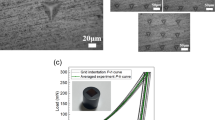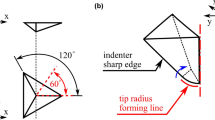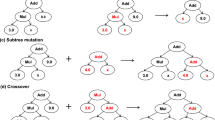Abstract
Nanoindentation can effectively evaluate the mechanical properties of materials in the form of bulk and coating. However, the relationship between the indentation response and the stress–strain curve of thin-film elastoplastic materials is complex and thus difficult to be elucidated using traditional physics-based, empirical or statistical models. In this study, the convolutional neural network (CNN), as a practical machine learning method, is adopted and trained to rapidly obtain the mechanical properties of thin-film elastoplastic materials using nanoindentation. The proposed method is targeted for efficiently predicting mechanical properties of thin-film materials from the applied load–penetration depth curve. Combined with the power-law model to describe the elastoplastic characteristics, a dataset comprising 228 nanoindentation cases with wide ranges of material properties is numerically simulated by ABAQUS and the corresponding results are adopted for the CNN training and validating. By addressing the important elastoplastic properties characterized by elastic modulus, yield strength, and hardening exponent, the impacts of CNN’s architecture and training epochs on the predicting performance are investigated in detail. By varying the number of convolutional layers, the influence of mechanical parameters of thin-film materials on the CNN prediction accuracy is discussed. The results show that compared with the traditional reverse algorithm, CNN can greatly reduce the computational complexity and computation time and has better prediction accuracy for the constitutive parameters of thin-film elastoplastic materials.




Similar content being viewed by others
References
Fischer-Cripps AC. A review of analysis methods for sub-micron indentation testing. Vacuum. 2000;58:569–85.
Hay JL, Pharr GM. Instrumented indentation testing. ASM Handb Mech Test Eval. 2000;8:232–43.
Lucas BN, Oliver WC. Time dependent indentation testing at non-ambient temperatures utilizing the high temperature mechanical properties microprobe. MRS Online Proc Libr Arch. 1994;356:645–50.
Oliver WC, Pharr GM. An improved technique for determining hardness and elastic modulus using load and displacement sensing indentation experiments. J Mater Res. 1992;7(06):1564–83.
Lucca DA, Herrmann K, Klopfstein MJ. Nanoindentation: measuring methods and applications. CIRP Ann. 2010;59(2):803–19.
Johnson KL. Contact mechanics. New York: American Society of Mechanical Engineers; 1985.
Fischer-Cripps A, Johnson K. Introduction to contact mechanics (Mechanical engineering series). New York: Springer; 2007.
Ling F, Lai W, Da L, Puri P. Fundamentals of surface mechanics with applications. Appl Mech Rev. 2003;56:B41–2.
Yan W, Pun CL, Simon GP. "Conditions of applying Oliver-Pharr method to the nanoindentation of particles in composites. Compos Sci Technol. 2012;72(10):1147–52.
Oliver WC, Pharr GM. Measurement of hardness and elastic modulus by instrumented indentation. J Mater Res. 2004;19(1):13–20.
Bhushan B. Handbook of micro/nanotribology. Boca Raton: CRC; 1995.
Choudhury SF, Ladani L. Grain growth orientation and anisotropy in Cu6Sn5 intermetallic: nanoindentation and electron backscatter diffraction analysis. J Electron Mater. 2014;43(4):996–1004.
Oyen ML, Cook RF. Load–displacement behavior during sharp indentation of viscous–elastic–plastic materials. J Mater Res. 2003;18(1):139–50.
Swadener JG, Pharr GM. Indentation of elastically anisotropic half-spaces by cones and parabolae of revolution. Philos Mag A. 2001;81(2):447–66.
Long X, Feng YH, Yao Y. "Cooling and annealing effect on indentation response of Lead-Free solder. Int J Appl Mech. 2017;9:1750057(1)-1750057(13).
Long X, Jia QP, Li Z, Wen SX. Reverse analysis of constitutive properties of sintered silver particles from nanoindentations. Int J Solids Struct. 2020;2:191–2.
Chollacoop N, Dao M, Suresh S. Depth-sensing instrumented indentation with dual sharp indenters. Acta Mater. 2003;51(13):3713–29.
Dao M, Chollacoop N, Vliet K, Venkatesh TA, Suresh S. Computational modeling of the forward and reverse problems in instrumented sharp indentation. Acta Mater. 2001;49(19):3899–918.
Cheng YT, Cheng CM. Analysis of indentation loading curves obtained using conical indenters. Philos Mag Lett. 1998;77(1):39–47.
Li X, Liu Z, Cui S, Luo C, Zhuang Z. Predicting the effective mechanical property of heterogeneous materials by image based modeling and deep learning. Comput Methods Appl Mech Eng. 2019;347:735–53.
Roy A, Babuska T, Krick B, Balasubramanian G. Machine learned feature identification for predicting phase and Young’s modulus of low-, medium- and high-entropy alloys. Scri Mater. 2020;185:152–8.
Tian JW, Qi CC, Sun YF, Yeseen ZM. Surrogate permeability modelling of low-permeable rocks using convolutional neural networks. Comput Methods Appl Mech Eng. 2020;366:113103.
Zhu JS, Wang YL. Convolutional neural networks for predicting creep and shrinkage of concrete. Constr Build Mater. 2021;306:124868.
Kim HK. Multi-scale nonlinear constitutive models using artificial neural networks. Atlanta: Georgia Institute of Technology; 2008.
Xiong M, Zeng W, Fei T, Yu S, Zhou Y. Modeling constitutive relationship of BT25 titanium alloy during hot deformation by artificial neural network. J Mater Eng Perform. 2012;21:1591–7.
Zhang Y, Qiu J, Zhang YG, Liao R. The establishment of a constitutive model of sand under monotonic loading by adopting the support vector machine (SVM). Arab J Sci Eng. 2021;7:1–15.
Aslani F. A comparative study of cyclic constitutive models for concrete. Sunnyvale: LAP LAMBERT Academic Publishing; 2012.
Cun YL, Boser B, Denker JS, Henderson D, Jackel LD. Handwritten digit recognition with a back-propagation network. Adv Neural Inf Process Syst. 1990;2:396–404.
Zeiler M, Fergus R. Visualizing and understanding convolutional neural networks. Lect Notes Comput Sci. 2014;8689:818–33.
Ketkar N, Moolayil JJ. Convolutional neural networks. Berkeley, CA: Apress; 2021. p. 197–242.
Liu H, Zhang YF. Bridge condition rating data modeling using deep learning algorithm. Struct Infrastruct Eng. 2020;16:1447–60.
Zhuk DI, Isaenkova MG, Perlovich YA, Krymskaya OA. Finite element simulation of microindentation. Russ Metall (Metally). 2017;2017(5):390–6.
Gu JX, Wang ZH, Kuen J, Ma LY, Shahroudy A, Shuai B, Liu T, Wang XX, Wang G, Cai JF, Chen T. Recent advances in convolutional neural networks. Pattern Recognit J Pattern Recognit Soc. 2018;77:354–77.
Manaswi NK. Understanding and working with Keras. Berkeley, CA: Apress; 2018. p. 31–43.
Botchkarev A. A new typology design of performance metrics to measure errors in machine learning regression algorithms. Interdiscip J Inf Knowl Manag. 2019;14:045–76.
Acknowledgements
This work was supported by the National Natural Science Foundation of China (No. 52175148), the Natural Science Foundation of Shaanxi Province (No. 2021KW-25), the Open Cooperation Innovation Fund of Xi'an Modern Chemistry Research Institute (No. SYJJ20210409), and the Fundamental Research Funds for the Central Universities (No. 3102018ZY015).
Author information
Authors and Affiliations
Contributions
XL contributed to methodology, funding acquisition, supervision, and writing (review and editing); CL contributed to investigation, methodology, writing (the original draft), visualization, and software; ZS provided methodology and software; YS contributed to conceptualization and writing (review and editing).
Corresponding author
Ethics declarations
Conflict of interest
The authors declare that they have no known competing financial interests or personal relationships that could have appeared to influence the work reported in this paper.
Rights and permissions
Springer Nature or its licensor holds exclusive rights to this article under a publishing agreement with the author(s) or other rightsholder(s); author self-archiving of the accepted manuscript version of this article is solely governed by the terms of such publishing agreement and applicable law.
About this article
Cite this article
Long, X., Lu, C., Shen, Z. et al. Identification of Mechanical Properties of Thin-Film Elastoplastic Materials by Machine Learning. Acta Mech. Solida Sin. 36, 13–21 (2023). https://doi.org/10.1007/s10338-022-00340-5
Received:
Revised:
Accepted:
Published:
Issue Date:
DOI: https://doi.org/10.1007/s10338-022-00340-5




